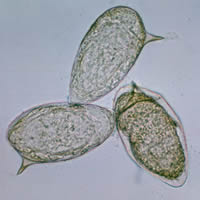General Flatworms
 There are thousands of different types of flatworms, most are not dangerous to humans.
There are thousands of different types of flatworms, most are not dangerous to humans.
Flatworms belong to one of four subsidiary groups. Those found in streams, ponds, moist soils, and the sea are the turbellarians. They are free-living, that is they move about looking for food. The other three groups – the Tremotada (flukes), Cestoda (tapeworms), and Monogenea – are all parasitic.
Flatworm and it's environment
The trematodes (e.g., liver-fluke) live in or on a variety of hosts but still retain their own gut. The cestodes (tapeworms) are so specialized that they have lost their gut; food is absorbed directly through the surface of their bodies from the surroundings in which they live. Monogenea are close relatives of the tapeworms but have a simple digestive system; they are found most commonly on the skin, fins, and gills of fish
MonogeneaMain article: Monogenea
There are about 1,100 species of monogeans. Most are external parasites that require particular host species, mainly fish but in some cases amphibians or aquatic reptiles. However, some are internal parasites. Adult monogeans have large attachment organs at the rear, haptors (Greek, haptein, means "catch"), which have suckers and hooks.
Symptoms and problems
Over half of all known flatworm species are parasitic, and some do enormous harm to humans and their livestock.
Schistosomiasis, caused by one genus of trematodes, is the second most devastating of all human diseases caused by parasites, surpassed only by malaria.
See also the trematodes (e.g., liver-fluke) and the cestodes (tapeworms)
Diagnosis
Treatement
Prevention
The threat of platyhelminth parasites to humans in developed countries is rising because of organic farming, the popularity of raw or lightly-cooked foods, and imports of food from high-risk areas. In less developed countries, people often cannot afford the fuel required to cook food thoroughly, and poorly-designed water-supply and irrigation projects increase the dangers presented by poor sanitation and unhygienic farming.
The main lines of precaution are those dictated by sanitary science:
- Use a water filter
- Do not use human excrement or raw sewage or untreated 'night soil' as manure/fertilizer in agriculture
- Do not walk barefoot in known infected areas
- Thoroughly washing food and cooking food
- Washing hands after going to the toilet, and before handling or eating food.
- Using safe food preparation practices.
- Cleaning of animal living areas regularly, and hygienically collecting and disposing of faeces.
- Checking sewage systems often to ensure they are not broken or faulty.
